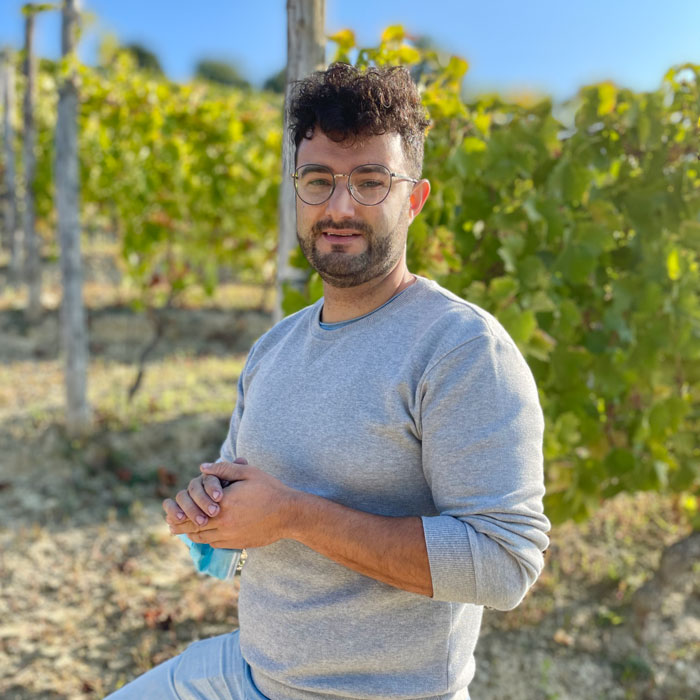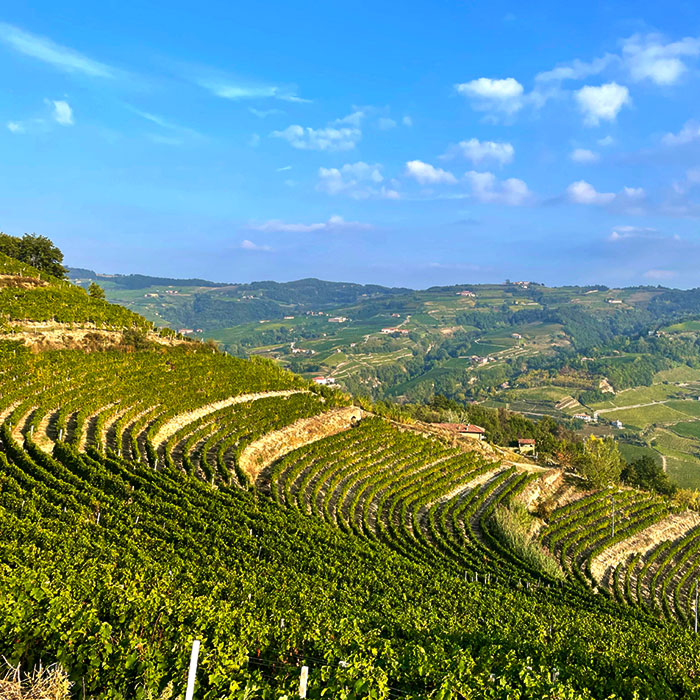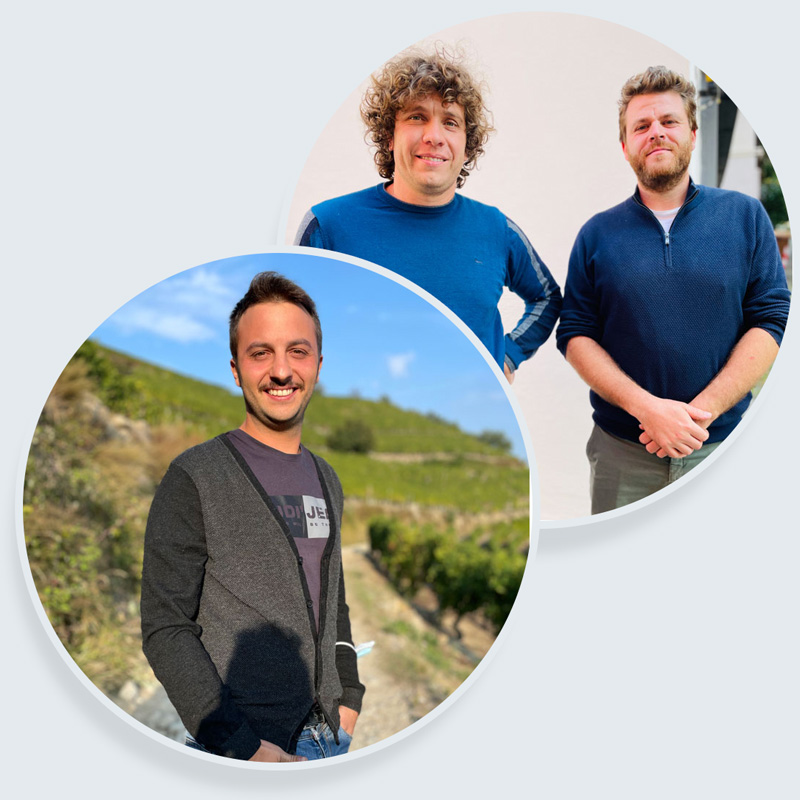 Francesco Bocchino (Tojo Winery) © Photo: Raffaella Usai
Francesco Bocchino (Tojo Winery) © Photo: Raffaella UsaiFrancesco Bocchino from Tojo Winery needs almost 1,000 working hours per year to cultivate one hectare of steep slopes. Almost everything has to be done manually, his vineyards are too sloping for larger machines, the distances between the rows of vines too small. I stand with the winegrower on one of his slopes. The morning sun is warming our faces, I'm a bit out of breath from the climb. From up here, the view is unbelievably beautiful. We are in the municipality of Santo Stefano Belbo, in the heart of the Moscato region, looking across an undulating sea of hills to the west towards Castiglione Tinella.
These hilly vineyards are called "Sorì" in the Piedmontese dialect. This means "hills kissed by the sun", explains Francesco Bocchino, "because the vines here enjoy particularly intense sunlight". There are about 1,400 hectares of these steep sites in the growing area. They have a slope of more than 40 per cent, and in some cases the slope is even up to 60 per cent. They are unsuitable for machines. "Those who work these steep slopes with a small tractor risk their lives. But many do it to save costs and effort," says the 28-year-old. His vines are on average 60 years old and therefore very closely planted. The rows are less than 1.50 metres apart. No tractor can fit through that. "As long as smaller, remote-controlled machines and drones are only used on an experimental basis to apply pesticides, I have to do all the work manually," says Francesco.
Steep slope viticulture lives on idealists, whether on the Moselle, the Douro or here. The winegrowers who tend their vines in the Moscato region under tough conditions don't do it because they get extra money for it. They do it out of love and a sense of responsibility - and because they want to save the historic sites from decay. There is a dramatic shortage of labour in the steep slopes. Often it is old people who look after their vineyards, exploiting themselves. Until one day they can no longer. As a result, more and more of these vineyards are left to their own devices. And this is not only a pity, but also a serious problem, because the overgrown plots increase the risk of landslides. This was particularly dramatic in the Cinque Terre in autumn 2011, when whole villages were buried under masses of mud after heavy rainfall.
"Many vineyards have already been abandoned because the old people can no longer manage the work and they are not profitable for the young. These vines take a lot of effort that doesn't pay off in the end," Francesco describes in frustration. Because the big wineries and sparkling wine houses pay just as much for Moscato grapes from the steep slopes as for those from the mechanisable flat slopes: depending on the vintage, it's around 1.10 euros per kilo. Francesco Bocchino also sells most of his grapes; he is dependent on the spumante industry. So far, he bottles only 25 per cent under the name Tojo. "My goal is to market everything myself at some point. That's the only way I'll be able to make a good living from it," says Francesco and looks confidently to the future.
 The vineyards of Poderi Roccanera © Photo: Raffaella Usai
The vineyards of Poderi Roccanera © Photo: Raffaella UsaiThe Moscato universe is a complex social structure with imposing numbers. In 51 municipalities in the three provinces of Alessandria, Asti and Cuneo, the Moscato bianco grape is cultivated on a total of 9,700 hectares. Of these, 1,400 hectares are cultivated under difficult conditions. The tone is set by the sparkling wine houses and the cellar cooperatives. They market most of the production and dictate the prices; self-marketing wineries are in the minority. Many winegrowers bottle only part of their production under their own name and sell grapes or must to large wineries. Thus, the grape price is primarily responsible for the social balance of the appellation: it determines the fate of many vineyards.
The Moscato grape is used for the production of both Asti Spumante DOCG and Moscato d'Asti DOCG. While Asti Spumante is largely an industrial product for the grocery trade, Moscato d'Asti, since Romano Dogliotti bottled his first bottle in the mid-1970s, has made a name for itself as a winegrower's wine. Around 50 million bottles of Asti Spumante and 35 million bottles of Moscato d'Asti are produced annually. Since the international demand for Moscato d'Asti has increased noticeably in the past ten years, the sparkling wine houses are producing less and less Asti Spumante, but are also serving their customers with Moscato d'Asti. The boundaries are blurring. What used to be clearly separated is becoming more and more softened. The president of the Asti Consortium, Lorenzo Barbero, assumes that the production figures will continue to converge in the future and that Spumante and Moscato will balance each other out.

In order to prevent in the future even more steep slopes from being abandoned, a group of winemakers launched the collective brand "Sorì Eroici" in 2021. The registered trademark is based on a process of many years, including the mapping of 20,000 hectares of vineyards. Luca Luigi Tosa, one of the co-founders of the project and vice-mayor of the municipality of Cossano Belbo explains: "We want to enhance the value of the steep slope wines from the Langhe, Roero and Monferrato wine-growing areas and raise consumer awareness. It's an important signal for our region and I hope that many more wineries will join us."
 Emanuele Contino (Teresa Soria) & Gabriele Saffirio (Azienda 499) / Alessandro Negro (Poderi Roccanera) © Photo: Raffaella Usai
Emanuele Contino (Teresa Soria) & Gabriele Saffirio (Azienda 499) / Alessandro Negro (Poderi Roccanera) © Photo: Raffaella UsaiSo far, 13 wineries with a total of 44 hectares of steep slopes have signed up to the protocol. The requirements are vineyards with a slope of at least 40 percent that cannot be mechanised or vineyards with a slight slope that must also be cultivated manually. North-facing vineyards are excluded. Producers must also prove that they manage their vineyards sustainably - either organically, biodynamically or integrated. Emanuele Contino from the Teresa Soria winery underlines why this is so important to the winemakers: "Since 2014, the vineyards of Langhe, Roero and Monferrato have been Unesco World Heritage Sites. For us, the focus was on preserving the beauty of our region and protecting it. Therefore, sustainability certification is a fundamental aspect of the accreditation. A generational change is currently taking place on many farms, and this also entails a rethinking of pesticides and herbicides."
The "Sorì Eroici" project includes all 51 municipalities in the Moscato area, but is not limited to Moscato. If the vineyards meet the criteria, Barbera, Dolcetto or Nebbiolo can also be awarded the logo. It is important that the wines from the certified vineyards are vinified and bottled separately. The first bottles from the Teresa Soria, Poderi Roccanera, Rocche di Moncucco and Rapalino wineries are now available, and more winemakers will follow in the coming months.
"My steep-slope Moscato costs more than the other wines that come from flatter sites. And it has to be, because consumers should understand right away that there is a special effort in this bottle. I am confident that we can convince our colleagues that this is the right way to lead our region into a secure future, even through the higher price," says Emanuele Contino.
Header photo: © Exploria